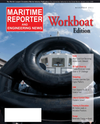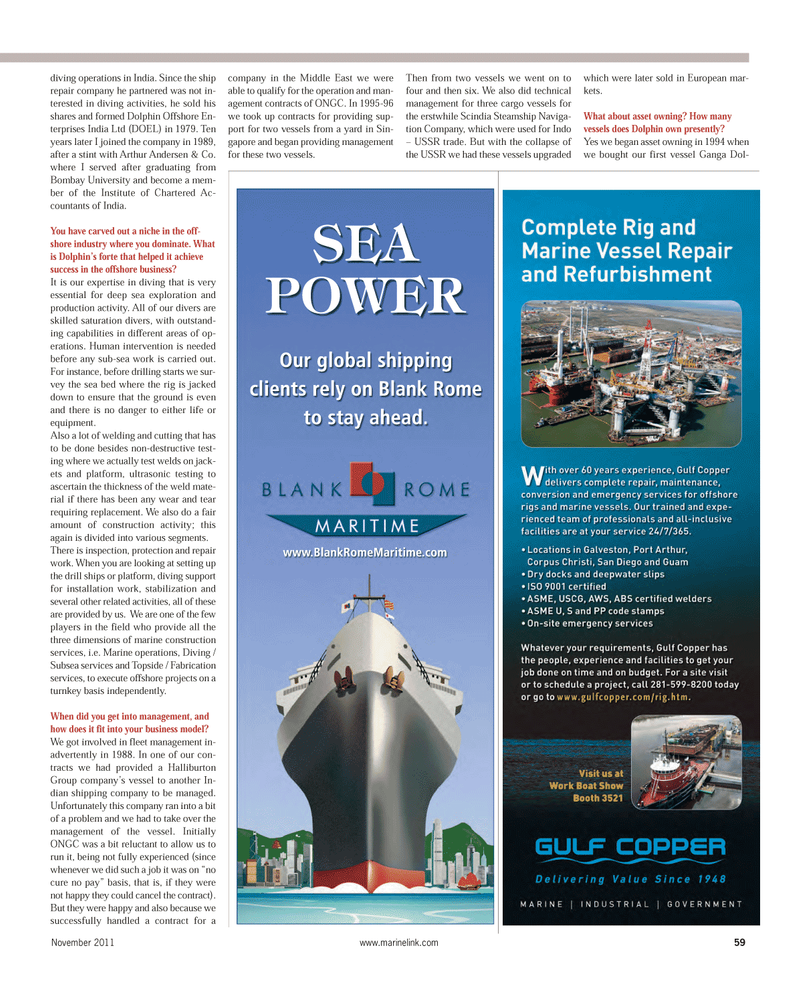
Page 59: of Maritime Reporter Magazine (November 2011)
Feature: Workboat Annual
Read this page in Pdf, Flash or Html5 edition of November 2011 Maritime Reporter Magazine
diving operations in India. Since the ship repair company he partnered was not in- terested in diving activities, he sold his shares and formed Dolphin Offshore En- terprises India Ltd (DOEL) in 1979. Ten years later I joined the company in 1989, after a stint with Arthur Andersen & Co. where I served after graduating from Bombay University and become a mem- ber of the Institute of Chartered Ac- countants of India. You have carved out a niche in the off- shore industry where you dominate. What is Dolphin?s forte that helped it achieve success in the offshore business? It is our expertise in diving that is very essential for deep sea exploration and production activity. All of our divers are skilled saturation divers, with outstand- ing capabilities in different areas of op- erations. Human intervention is needed before any sub-sea work is carried out. For instance, before drilling starts we sur- vey the sea bed where the rig is jacked down to ensure that the ground is even and there is no danger to either life orequipment.Also a lot of welding and cutting that hasto be done besides non-destructive test- ing where we actually test welds on jack-ets and platform, ultrasonic testing toascertain the thickness of the weld mate-rial if there has been any wear and tear requiring replacement. We also do a fair amount of construction activity; this again is divided into various segments. There is inspection, protection and repairwork. When you are looking at setting up the drill ships or platform, diving support for installation work, stabilization and several other related activities, all of these are provided by us. We are one of the few players in the field who provide all the three dimensions of marine constructionservices, i.e. Marine operations, Diving / Subsea services and Topside / Fabrication services, to execute offshore projects on a turnkey basis independently. When did you get into management, and how does it fit into your business model? We got involved in fleet management in- advertently in 1988. In one of our con- tracts we had provided a Halliburton Group company?s vessel to another In- dian shipping company to be managed. Unfortunately this company ran into a bit of a problem and we had to take over the management of the vessel. Initially ONGC was a bit reluctant to allow us to run it, being not fully experienced (since whenever we did such a job it was on ?no cure no pay? basis, that is, if they were not happy they could cancel the contract). But they were happy and also because we successfully handled a contract for acompany in the Middle East we were able to qualify for the operation and man-agement contracts of ONGC. In 1995-96we took up contracts for providing sup- port for two vessels from a yard in Sin- gapore and began providing management for these two vessels. Then from two vessels we went on to four and then six. We also did technical management for three cargo vessels for the erstwhile Scindia Steamship Naviga- tion Company, which were used for Indo ? USSR trade. But with the collapse ofthe USSR we had these vessels upgraded which were later sold in European mar- kets. What about asset owning? How many vessels does Dolphin own presently? Yes we began asset owning in 1994 when we bought our first vessel Ganga Dol- November 2011www.marinelink.com 59MR Nov.11 # 8 (57-64):MR Template 11/2/2011 1:45 PM Page 59

 58
58

 60
60
